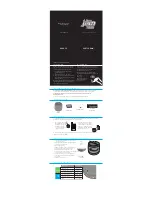
KALI AUDIO LP-6/LP-8 2nd Wave Studio Monitors User’s Guide
16
Troubleshooting
1. I opened the speaker, and it is damaged.
If you received a speaker that is obviously damaged, please contact your dealer immediately.
2. The speaker is making no sound.
• Is the speaker plugged in?
• Is the speaker turned on? There should be a blue LED on the front of the speaker if it’s on. If this light is
off, the speaker is turned off.
• Is the volume turned up?
• Are all cables plugged in to both your playback device and the speaker?
• Are you passing audio via your playback device?
• Are you using RCA? If so, have you moved dip switch #8 UP to the ON position?
If you’ve answered “Yes” to all the above and the speaker is still not making any sound, refer to number 5
below.
3. The speaker sounds distorted.
• Is the speaker playing too loud? Turn down the volume on the back of the speaker. If the distortion goes
away, you may be playing the speaker too loud. Besides the problem of distortion, this can be damaging
to your hearing if you are close to the speaker.
If you’ve turned down the volume on the speaker, and you’re still hearing distortion, refer to number 5
below.
4. I hear cracks, hums, or buzzing.
• Are you using RCA?
a. If “yes,” be advised that RCA is an unbalanced connection, and is prone to picking up noise as sig
nal travels through the cable. This is especially true if you are using very long RCA cables.
b. If “no,” be sure that the dip switch # 8 is moved DOWN to the OFF position.
• Is the speaker close to electronics like a television, wireless router, phone, motor, or radio? If so, these can
interact with the speaker’s magnet in ways that cause unwanted noise. Try moving the speaker at least
.5 Meters (20 inches) from any such devices.
•
Are there loose objects in the room that may be buzzing with the bass? Low frequencies can cause ob
-
jects in a room to vibrate loudly. Make sure that small, hard objects like screws and other hardware are
secure.
If none of the above solves the problem, refer to number 5 below.
5. Isolate the problem
There are many issues in the signal path which might be causing any of the above problems. Before you
initiate a return, do your best to make sure that the problem isn’t with your cables or your playback device.
Here’s a simple way to check:
• Disconnect your speaker from your source.
• Plug in the problematic speaker and allow it to play for a minute. Take careful note of the problems
you’re hearing.
• Disconnect the problematic speaker, and plug that same cable into another speaker. If you’re hearing
the same issues, there is likely a problem in your signal path, and not the speaker.
•
If you’ve determined that your problem is with your speaker, contact your dealer to initiate a return.


































